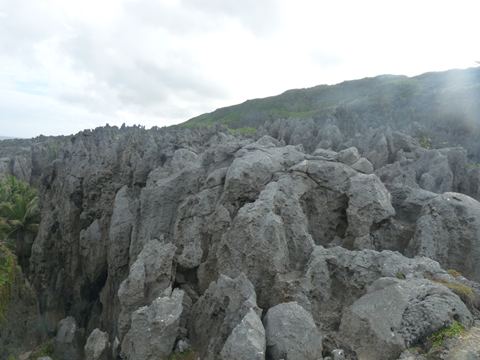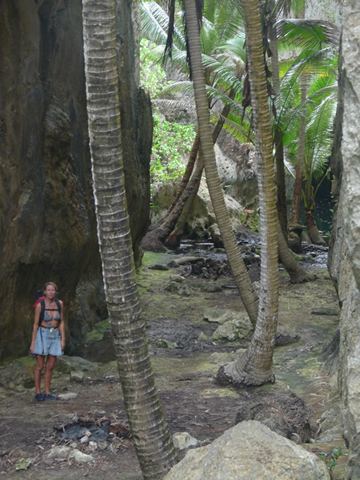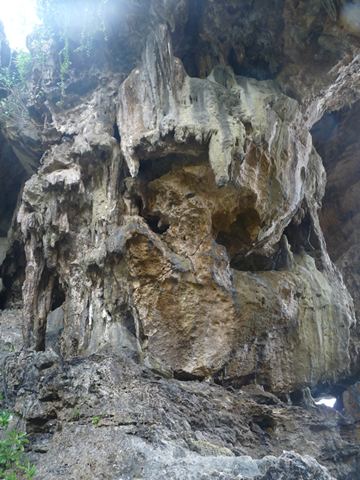Niue

Catacaos
Graham Shaw
Wed 14 Sep 2011 05:30
|
Before leaving Palmerston, we were very lucky to be
included in the last bird hunt of the season. This happens 3 or 4 times a
year when bosun birds are collected and then divided up amongst the
islanders depending on how many people are in each family. They are then
killed, plucked, seared and put in an umu (Polynesian underground oven) for
cooking. These birds were not to everyone's taste, but I actually
quite liked it, very different taste than I thought - not fishy at all.
Gray facetiously asked the head of one of the families if it tasted like
chicken? He replied "It does a bit", and then he thought about it for
minute, and added "but it tastes more like bird"!
 Collection net for the Bosun birds, which look a
bit like seagulls.
 One of the youngters plucking a bird.
Lucas was quite taken with this little girl.
 Simon and Goodly, the bird officials, dividing the
catch.
Before we had the bosun bird feast, we
attended church. The singing was very vocal, and mainly sang in Cook
Islands Maori language, with the older generation putting the youngsters to
shame. Very beautiful, clearly had some religious stuff in the middle
somewhere, where a lot of the children read from passages from their King
James versions - they are keen to point out this is what
most of their religion is based on. Men sat on one side in the
church, women on the other. The visiting yachties were made very welcome -
we are generally the only visitors they get, as the supply ship only calls there
every three months and is often delayed by a month or two. The only
non-yachting visitor there at the time of our visit was Rose (see below) who
will have been there for five months by the time the next ship comes. Not
much use to the average tourist!
 In church all the women have to wear longish
skirts, covered shoulders and a special hat. In this picture outside the
church left to right are Kirk (of Canadian yacht Discovery - never anchor
behind him), me, Gray with Lucas, Claire (Kirk's daughter), Eric (Kirk's crew),
Yvonne (the local headmistress), Terry, the pastor (and husband of Yvonne),
their daughter Shakina, Gail (of the shipwrecked Ri Ri, and now onboard
Catacaos for onward passage to Tonga), Rose (from Bridport in
Dorset), whose father was ship wrecked in Palmerston in the 60's, and
has returned to scatter his ashes, and Frank, the owner of Ri
Ri.
From Palmerston (the last of the Cook Islands) it
was a short passage to Niue, but very nice. With Frank and Gail joining
us, more people to do night watches make a very easy passage for us.
Arriving in Niue, we saw a number of whales blowing on the way in. Plus
when we arrived in the anchorage a turtle came up to say hello, and
then a mother and calf humpback whale.
  Mother and calf humpback whales.
Awesome!!!
Niue is an independent country - one of the
smallest states in the world, yet is the largest lump of coral which there
is. There are no rivers or streams, so any runoff rainfall is filtered
through the coral and limestone caves. This leads to some of the most
extraordinary underwater visibility in the world. In fact visibility of
seventy metres in not uncommon, reducing to forty metres on a bad day. We
were on a mooring in 14 metres of water and could see the bottom at night!
Niue is a lovely island with many places to walk, mainly sea treks down to
beaches or chasms. We hired a car and managed to reach the treks further
afield, and also we were able to visit a village show day. This
is a monthly event where each village alternates putting on the
show, which starts very early in the morning - 6am and goes onto 11
am. We did not make the early start but we managed to catch some of the
dancing. The island is about 100 square miles with 1600-odd inhabitants,
so about twice the size of Jersey with it's nearly 100,000
inhabitants!
 Lots of coconut crabs to be seen and could be
bought, but a little pricey for my liking between 50 and 100 NZ $ for one
crab.
 Good eating apparently!! I'll have to catch
one.
 Local produce for sale.
 Togo chasm, which was very impressvie. The
walk was about 1km through huge coral. The ladder down into the chasm was
not quite to Gray's liking though.
  Coral which stretched for miles.
 What a poser.
    Limu pool, which is a beautiful snorkeling area -
followed by the arches.
 Inside the caves it was all very
different.
Niue was hit by a devastating cyclone in 2004,
which wiped out the 90% of the buildings on the island. The main
road leading south out of town had many houses which were washed
away by the storm surge. We struggled to imagine this, as the road has an
elevation of 26 metres, and the water was 2 metres deep in the road. Yes,
with 300kmh winds, the water was forced ashore to a height of 28
metres above sea level.
 Huge caves at Palaha.
 Sea snake looking for dinner. There are lots
of these in the water, you have to be careful not to run into them while
swimming. They are poisonous, but generally will not bite you
apparently?
 We were very fortunate to be in the island the same
time as the whale research people from Whalesalive, and were able to take them
out on Catacaos to go looking for whales. We were out for about 6 hours,
and followed a mother and calf, a number of whales logging, and some
fluking, and most impressive was a couple of whales breaching - fantastic.
I was never quick enough with the camera though. The
research covers identifying each individual whale which is done by a
photograph of the underside of the tail, which is like a finger print
- every one is different. They also photograph dorsal fins and can
part identify them from this, and also take skin samples, from which they
can make DNA analysis. The whole day was very interesting and
imformative in many ways, and the whales putting on a show for us was an
added bonus.
 Cara and Olive of the Whale Research Team listening
and recording whalesong with a
hydrophone.
  More caves.
 Little shindig at Glenda's house. Glenda is
hosting the whale researcch time during their time in Niue. It
was lovely evening in a beautiful house overlooking the sea, and the
whales.
We have had a very interesting time in Niue. The
Niue Yacht Club who look after the moorings are so hospitable - they should be
voted the most helpful yacht club in the Pacific. They have members from
all over the world but they do not posses a yacht. ( anyone want to donate
one?). The anchorage was great until the wind came around from the west,
which does not happen very often, but with a 3 metre swell it was awful. A
guy in the anchorage managed to crush and remove part of his middle finger
on a line caught up on his anchor, so emergency lift to shore, which in normal
circumstances is okay, but with the dock awash with water, and the boat lurching
about it was very treacherous. After this incident two boats whose crew
were ashore started chafing through their mooring lines (chafing on their
anchors), so there more fun and games. One boat was very lucky as it was
down to the last strands on the last line - also it did not have a working
engine. This boat would have been on the reef within seconds. A group
effort from three different boats sorted out the two boats in peril, in very
dangerous conditions. I have to say my heart was in my mouth watching
Gray, Jamie and Jason being thrown all over the place. Good news though
that Charles from Dreamcatcher had his finger sewn back on and it seems to be
taking up ok.
As usual we have tried to find a good weather
window to leave, but there is either too much wind or not enough. We need to
keep moving as time is getting short, and we now are heading off to Tonga -
should be there in two days when hopefully we can send the backlog of
blogs.
At last the one that did not get away.
 |